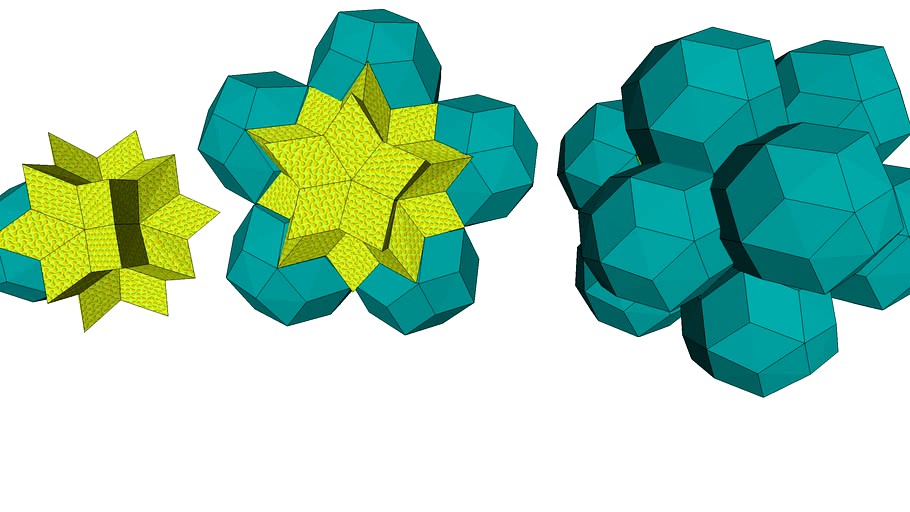3DWarehouse

Rhombic Hexecontahedron and Rhombic Triacontahedra clusters combined to form Quasicrystal
by 3DWarehouse
Last crawled date: 3 years, 4 months ago
Rhombic Hexecontahedron is the star bust shape that act as landing ports for the 12 Rhombic Triacontahedra. Note both polygons contain 5 , 10 fold geometries. Up to recently it was thought that tessellating or clustering into crystal forms was an impossibility for any natural number multiples of 5 fold geometries. Note in the half covered center cluster the 2D projection yield the Penrose Rhombus tiling (P3). Note. That the construction of Rhombic Hexecontahedron combines the Icosahedrons and the Dodecagon forms. Both are constructed with Golden Ratio proportions. Thus quasicrystals are related to the Golden ratio. Professor of Materials Science Dan Shechtman discovered the icosahedra phase, which opened the new field of quasiperiodic crystals. Shechtman was awarded the 2011 Nobel Prize in Chemistry for the discovery of quasicrystals, making him one of six Israelis who have won the Nobel Prize in Chemistry. Note the only natural occurring cluster of the above named cluster were extraterrestrial namely from meteorites. Note synthetic quasi crystal strengthens some metal and display remarkable insulation and magnetic properties. Islamic Art: In 2007 two physicists in the US reported that they had found an example of a 15th-century geometric pattern in Iran that showed an 'almost perfect' example of Penrose tiling. These researchers concluded that the Islamic craftsmen most likely created the patterns using a set of tiles of distinct shapes, each decorated with lines that join to form the final patterns. Several other studies have also suggested that quasiperiodic patterns in Islamic architecture were constructed through local rules such as subdividing or overlapping of tiles. But none of the proposed methods has able to explain how the ancients ended up creating global long-range order in their patterns. Now an explanation may be at hand. In this latest work, Rima Ajlouni, an architectural researcher at Texas Tech University in the US, believes that she has identified three examples of quasiperiodic patterns in Islamic architecture without any imperfections. The first pattern is a quasiperiodic cartwheel pattern that commonly used in the architecture of the Seljuk region, an empire that stretched from Turkey to Afghanistan. Ajlouni identifies specific cases in Iran at the Darb-i Imam shrine and the Friday Mosque in Isfahan. The second pattern is from the interior walls of the courtyard of the Madrasa al-'Attarin in Fez, Morocco, dating back to 1323. And the third case, dated to 1197, is seen on the external walls of the Gunbad-I Kabud tomb tower in Maragha, Iran. From seed to beauty In her paper, Ajlouni also shows that ancient Muslim designers were able to resolve the complicated long-range principles of quasicrystalline formations. In other words, these designers were fully aware of the extent of connectedness within their work. In all three examples, Ajlouni reconstructs the patterns and shows that the size of a central 'seed' figure is proportional to the size of the overall framework of the pattern. She demonstrates that the three patterns could have been created using nothing more than a compass and a straightedge. This construction method that was widespread in Islamic societies to create a variety of media such as woodworks, ceramics and tapestries. or PASTE your text here... #3d_tessellations #constuction_of_Quasicrystal #Islamic_Art
